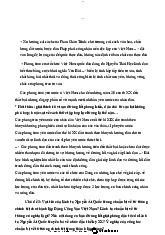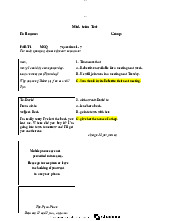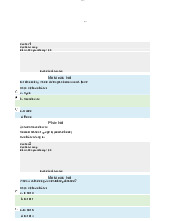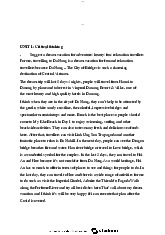











Preview text:
LESSON 2: PURCHASES, SALES AND EXPENSES
After carefully studying this lesson, you should be able to:
1. recognise the various meanings attributed to the term ‘purchases’
2. record in double-entry form (i) the purchase, and (ii) the sale of goods
for cash and on credit; & (iii) the return of goods
3. appreciate the nature of and types of ‘expenses’
4. record the withdrawal of profit by ‘drawings’ INTRODUCTION
You will learn about the appropriate accounts in which to record the
increases and decreases in stock and how to record purchases and sales
on credit, in contrast to purchases and sales for cash. In addtion, you will
learn how to enter double entry transactions for expenses and revenues.
You will also learn about the effects that profit, loss and drawings have on capital. I. PURCHASES
In the balance sheet of Lesson 1 so far the item ‘goods’ has been included.
This refers to goods in which the firm trades and not to items such as the
motor vehicle or office furniture which are shown separately and will be kept for use in the business.
If every purchase or sale of goods were entered under the one heading
‘goods’, you would have a confused picture of what was happening. You need
to know for a given period (e.g. week, year) the total amount of purchases (of
goods for re-sale) as distinct from the total amount of sales. Therefore, we
have Purchases account and Sales account.
Let it be absolutely clear about what is meant by the term ‘purchases’. It means goods (i)
bought with the intention of reselling them as part of the firm’s trading
activities: goods in which the firm ‘deals’. or (ii)
bought in order to use them in the manufacture of other goods (e.g. raw
materials or in some way to change their form, e.g. the re-packaging of
goods carried out by some wholesalers. The intention is the same as in (i) but it is less direct.
Methods of payment can be made either (i)
purchases for cash (purchases of goods with immediate payment in cash or by cheque) or (ii)
purchases on credit (purchases of goods with payment to be made at later date)
You will now see the book entries for purchases.
I.1. Purchases of goods on credit
Refer to example (iii) in Lesson 1:
On 9 May Year 3, James Meredith bought goods on credit £180 from Rendell Supplies. As in Lesson 1 From this lesson Goods Purchases Year 3 £ Year 3 £ May 9Rendell May 9Rendell Supplies 180 Supplies 180 Rendell Supplies Rendell Supplies Year 3 £ Year 3 £ May 9 Goods May 9 Purchases 180 180
The goods account used in Lesson 1 is now replaced with a purchases account.
However, the same rules will apply: where you debited goods account for an
increase in asset amount, likewise you will debit purchases account.
I.2. Purchases of goods for cash
E.g. On 15 May Year 3, bought goods for £210, payment being made immediately by cheque.
In this transaction, there is an increase in asset account: Purchases. As there is
an increase in asset value, this will be debited.
The payment was made by cheque, so the money in bank account (asset
account) decreased. According to the rules for double-entry, if asset account
decreases, it will be credited. Purchases Year 3 £ May 15 Bank 210 Bank Year 3 £ May 15 Purchases 210
To summarise the book-keeping entries overall relating to Purchases: • Credit Purchase
- debit purchases account
- credit supplier’s (creditor’s) account • Cash Purchase
- debit purchases account
- credit Cash/ Bank account
In due course, payment will be made to the creditor, so
• Payment to creditor
- debit creditor’s account
- credit bank account or cash account II. SALES
The sale of goods means the decrease of an asset. Up to the present this has
been recorded to the credit of a goods account. Now, however, in order to
provide more information and to facilitate control, it is necessary to record all
sales of goods in a sales account, to include: (i)
sales ‘for cash’( goods sold with immediate payment, in cash or by cheque) (ii)
sales on credit (goods sold with payment to be received by an agreed future date)
II.1. Sales for cash
Refer to example (v) in Lesson 1:
16 May Year 3, sold goods for cash £270. As in Lesson 1 From this lesson Goods Sales Year 3 £ Year 3 May 16 Cash £ 270 May 16 Cash 270 Cash Cash Year 3 £ Year 3 £ May 16 Goods 270 May 16 Sales 270
The term ‘for cash’ will include sales for actual cash as well as where payment is
received immediately into the firm’s bank account (e.g. payment by cheque).
II.2. Sales on credit
E.g. 23 May Year 3, sold goods on credit for £65 to N Tibbs.
Sales account similarly will be credited, representing the asset decrease. N Tibbs
is a debtor (debtors belong to asset accounts) and now owes the business £65.
Hence N Tibbs’ account must be debited to show the increase in asset value. Sales Year 3 £ May 23 N Tibbs 65 N Tibbs Year 3 £ May 23 Sales 65
To summarise the book-keeping entries overall relating to sales: • Cash Sale
- debit Cash/ Bank account - credit Sales account • Credit sale
- debit customer’s (debtor’s) account - credit sales account
• When payment is received from the debtor
- debit bank account or cash account
- credit debtor’s account III. RETURNS
III.1. Returns Outwards
Sometimes goods already purchased will be returned to the supplier, who will
agree to make an allowance. This will be recorded in a returns outwards
account (or purchases returns account). A corresponding entry will be made
in the relevant creditor’s account.
E.g. 24 May Year 3, Goods are returned to Rendell Supplies (a creditor) and an allowance of £50 is agreed. Returns Outwards Year 3 £ May 24 Rendell Supplies 50 Rendell Supplies Year 3 £ May 24 Returns Outwards 50
The £50 credit on Returns Outwards account effectively decreases the debit
amount on the purchases account.
If we bring together the two transactions relating to Rendell Supplies, his account now appears: Rendell Supplies Year 3 £ Year 3 £ May 23 Bank 80 May 9 Purchases 180 May 24 Returns Outwards 50
The difference between the two sides is a credit excess of £50. The business
owes Rendell Supplies that amount.
III.2. Returns Inwards
Sometimes, Goods previously sold may be returned to the seller, for which there
will be an agreed allowance. This will be recorded in a returns inwards account
(alternatively, sales returns account) as well as in the account of the customer.
E.g. 26 May Year 3, N Tibbs returns the goods which he purchased on 23 May Year 3 Returns Inwards Year 3 £ May 26 N Tibbs 65 N Tibbs Year 3 £ May 26 Returns Inwards 65
The entry in the returns inwards account offsets the previous credit entry in the
Sales account. The credit entry on N Ttibb’s account cancels out the previous debit entry. N Tibbs Year 3 £ Year 3 £ May 23 Sales 65 May 26 Returns Inwards 65
This shows that N Tibbs now owes nothing.
To summarise the book-keeping entries overall relating to Returns:
• Returns outwards (or Purchases Returns)
- debit creditor’s account
- credit Returns Outwards account
• Returns Inwards (or Sales Returns)
- debit Returns Inwards account
- credit debtor’s account IV. EXPENSES
You now need to see how expenses are dealt with in the accounts.
If money is spent on buying an asset, such as office equipment, it is debited to
the asset account. Money has been spent on owing a resource. If expenditure is
on rent of premises, wages, telephone, etc. it is to obtain the use of a resource,
but paying for it ‘as you go’ rather than long in advance. It is therefore consistent
to debit the expenditure account, as one would the straightforward asset account.
Moreover, any expenditure will reduce profit and thus reduce capital. Any
reduction in capital needs to be debited: this further justifies the debit entry for expenses.
The owner of a business needs to know how much is being spent on each area
of expenditure. So, instead of having one ‘expense account’, it is usual to have
several, each one covering a category of expenditure. These may include items
such as: wages, salaries, rent, insurance and motor expenses, etc. Examples (i)
14 May Year 3, wages of £40 are paid in cash
Cash is reduced; therefore cash account should be credited. Expenditure on
wages (= for labour services) increases, so wages account should be debited with £80. Cash Year 3 £ May 14 Wages 40 Wages Year 3 £ May 14 Cash 40 (ii)
20 May Year 3, Insurance (against the risks of loss from fire and theft) is paid by cheque £55.
Payment by cheque results in a reduction in the balance of bank. Hence, bank account should be credited.
A period of insurance ‘cover’ is acquired. As this is effectively a resource of the
business, debit insurance account with £55. Bank Year 3 £ May 20 Insurance 55 Insurance Year 3 £ May 14 Bank 55 V. DRAWINGS
From time to time the owner will take money out of the business in the form of
cash (or withdrawal by cheque from the firm’s bank account) for his personal use,
not the business use. Occasionally the withdrawal may be in the form of goods or
services taken for the owner’s personal use. Therefore, the account related to the
withdrawals here is named “Drawings”.
The prudent owner will ensure that the amount he takes out on a weekly/ monthly
basis does not exceed the profit made by the business at that stage. Failure to
do so will result in a reduction in the capital account as might be expected.
Applying the double-entry rules, Drawings will make capital decrease, so
‘Drawings’ account must be debited. Money taken out of the business will reduce
money (reduce asset), hence Cash/ Bank account will be credited.
E.g. May 28 Year 3, James Meredith, the owner, withdrew for private use £130 cash. Cash Year 3 £ May 28 Drawings 130 Drawings Year 3 £ May 28 Cash 130
When the net profit has been determined and entered in the capital account, the
drawings account is closed by transferring the amount to the capital account.
This enables the drawings total to be set off against the net profit figure (and by
balancing the account, shows the amount owed to the owner at the end of the trading period).
Care must be taken not to confuse ‘drawings’ with expenses. To do so can give a
false picture of how the business is performing: total expenses might appear
much greater than they really are. SUMMARY
1. The purchases account is used to record the purchases of stock while the
returns inwards account is used to record goods returned by the business’s customers.
2. The sales account is used to record the sales of stock, while the returns
outwards account is used to record goods returned to supplers by the business.
3. Only goods bought with the intention of reselling them as a part of trading
activities are considered as purchases. The purchases of other assets is not considered as purchases.
4. Sales refered to the sale of those goods in which the business trades; the
sale of goods that were bought with the intention to resell.
5. The purchase or sale of goods for cash may involve payment or receipt being
made by cash or by cheque (bank).
6. Entries in an expense account will be on the debit side
7. Drawings are money or goods taken out of the business by the owner,
drawings are not an expense of the business
I hope you will be successful! GLOSSARY cash transaction (n) Giao d ch thanh toán ngay cheque (n) Séc commission (n) Tiền hoa hồng credit transaction (n) Giao d ch ghi nợ drawings (n) Rút vốn expense (n) Chi phí purchase (n) Việc mua hàng raw material (n) Nguyên liệu thô rent payable (n) Chi phí thuê trụ sở rent receivable (n) Tiền cho thuê trụ sở returns inwards (n) Hàng bán b trả lại returns outwards
Hàng mua trả lại cho nhà cung cấp sale (n) Việc bán hàng withdraw (v) Rút ra




